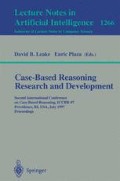Abstract
This paper reports preliminary work on developing methods automatically to index cases described in text so that a case-based reasoning system can reason with them. We are employing machine learning algorithms to classify full-text legal opinions in terms of a set of predefined concepts. These factors, representing factual strengths and weaknesses in the case, are used in the case-based argumentation module of our instructional environment CATO. We first show empirical evidence for the conncetion between the factor model and the vector representation of texts developed in information retrieval. In a set of hypotheses we sketch how including knowledge about the meaning of the factors, their relations and their use in the case-based reasoning system can improve learning, and discuss in what ways background knowledge about the domain can be beneficial. The paper presents initial experiments that show the limitations of purely inductive algorithms for the task.
We would like to thank Vincent Aleven for his support and numerous contributions to this research, in particular for making accessible CATO's Factor Hierarchy and Case Database.
Preview
Unable to display preview. Download preview PDF.
References
Aleven, V., and Ashley, K. 1996. How Different is Different? Arguing about the Significance of Similarities and Differences. In Proc. of the 4th European Workshop on Case-Based Reasoning, 1–15.
Aleven, V., and Ashley, K. 1997. An Empirical Evaluation of an Intelligent Learning Environment for Case-Based Argumentation. In AIED-97. to appear.
Ashley, K. 1990. Modeling Legal Argument, Reasoning with Cases and Hypotheticals. MIT-Press.
Branting, L. 1991. Building explanations from rules and structured cases. Internation Journal on Man-Machine Studies 34(6).
Callan, J.; Croft, W.; and Harding, S. 1992. The INQUERY Retrieval System. In Proc. of the 3rd Internat. Conference on Database and Expert Systems Applications, 78–83.
Callan, J. 1996. Document Filtering with Inference Networks. In Proc. of the 19th Annual International ACM SIGIR Conference.
Cowie, J., and Lehnert, W. 1996. Information extraction. Comm. ACM 39(1):80–91.
Cox, M. 1994. Machines that Forget: Learning from retrieval failure of mis-indexed explanations. In Proc. of the 16th Conf. of the Cognitive Science Society, 225–230.
Fox, S., and Leake, D. 1995. Learning to Refine Indexing by Introspective Reasoning. In Proceedings of the 1st International Conference on Case-Based Reasoning.
Frankes, W., and Baeza-Yates, R. 1992. Information Retrieval — Data Structures & Algorithms. Prentice-Hall.
Golding, A., and Roth, D. 1996. Applying winnow to context-sensitive spelling correction. In Proceedings of the 13th International Conference on Machine Learning.
Joachims, T. 1996. A Probabilistic Analysis of the Rochio Algorithm with TFIDF for Text Categorization. Technical report, Carnegie Mellon University. CMU-CS-96-118.
Lewis, D.; Shapire, R.; Callan, J.; and Papka, R. 1996. Training Algorithms for Linear Text Classifiers. In Proc. of the 19th Annual International ACM SIGIR Conference.
Mitchell, T. 1997. Machine Learning. Mc Graw Hill.
Osgood, R., and Bareiss, R. 1993. Automated Index Generation for Constructing Largescale Conversational Hypermedia Systems. In Proc. of the 11th National Conference on Artificial Intelligence, 309–314.
Papka, R.; Callan, J.; and Barto, A. 1996. Text-Based Information Retrieval Using Exponentiated Gradient Descent. In Neural Information Processing Systems. To appear.
Portinale, L., and Torasso, P. 1995. ADAPtER: An Integrated Diagnostic System Combining Case-Based and Abductive Reasoning. In Proc. of the 1st Int. Conf. on Case-Based Reasoning, 277–288.
Rissland, E., and Daniels, J. 1995. Using CBR to drive IR. In Proc. of the 14th International Joint Conference on Artificial Intelligence, 400–407.
Author information
Authors and Affiliations
Editor information
Rights and permissions
Copyright information
© 1997 Springer-Verlag Berlin Heidelberg
About this paper
Cite this paper
Brüninghaus, S., Ashley, K.D. (1997). Using machine learning for assigning indices to textual cases. In: Leake, D.B., Plaza, E. (eds) Case-Based Reasoning Research and Development. ICCBR 1997. Lecture Notes in Computer Science, vol 1266. Springer, Berlin, Heidelberg. https://doi.org/10.1007/3-540-63233-6_501
Download citation
DOI: https://doi.org/10.1007/3-540-63233-6_501
Published:
Publisher Name: Springer, Berlin, Heidelberg
Print ISBN: 978-3-540-63233-7
Online ISBN: 978-3-540-69238-6
eBook Packages: Springer Book Archive

